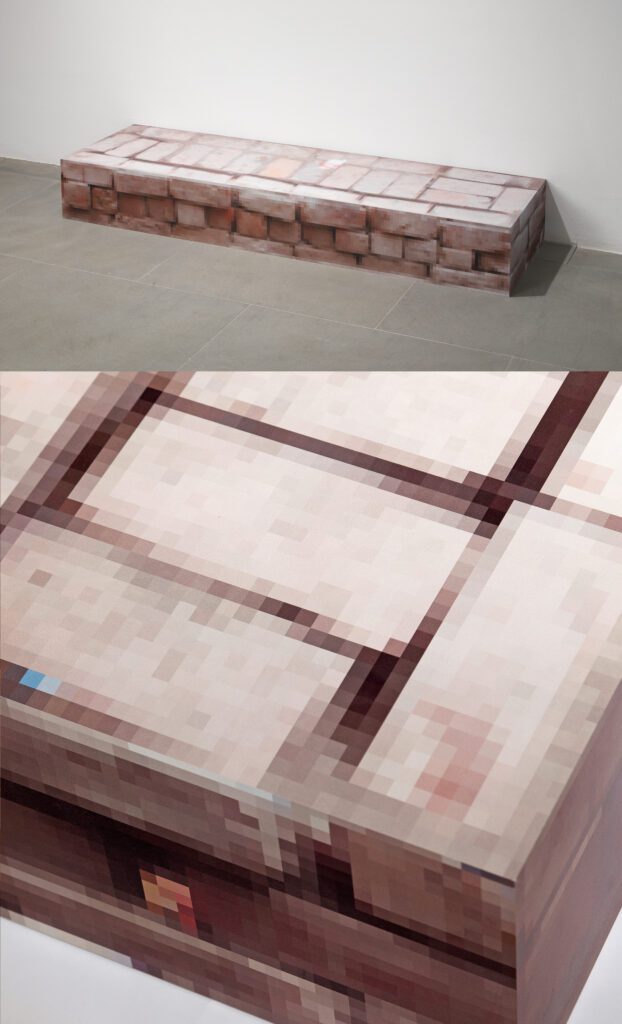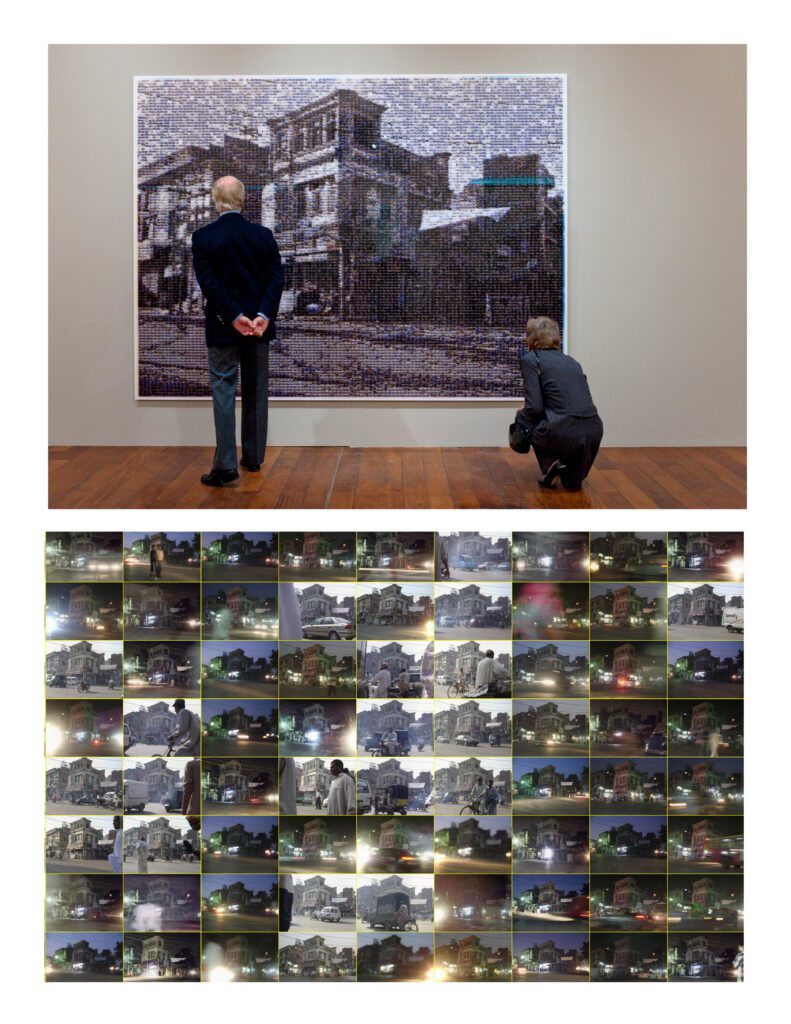As we lead up to the festival in March, you can find weekly interviews here on the blog with artists discussing their thoughts and practice around the festival theme of POST REALITY. For our first interview, we were lucky enough to sit with Rashid Rana.

Widely considered to be one of the leading artists of his generation in South Asia today, Rashid Rana emerged as the maker of an entirely new kind of art from Pakistan, at the start of this century. Notable for his ideas, imagery, and pictorial strategies, Rashid Rana has exhibited extensively at various galleries and museums globally. His works are in various public and private collections including the British Museum London, Metropolitan Museum New York, Fukuoka Museum of Art, Japan and Saatchi Collection, London. He is the recipient of the prestigious Game Changer Asia Art Award, and was awarded International Artist of the Year by SAVAC Canada in 2003.
Primarily known for his art practice, Rashid Rana in fact occupies multiple simultaneous profiles. He mediates between artist, curator and an academic with a common thread of an unfixed and non-prescriptive view of geography and identity. He is a founding faculty member and currently the Dean of the School of Visual Arts and Design at BNU, Lahore.
When it comes to investigating the possibilities of reality, there is perhaps no better artist to speak with than Rashid Rana, whose artistic practice has questioned the boundaries of physicality and virtuality for years. His photo-mosaics, video works and photo sculptures epitomize the dynamic tension of the digital and physical realities as they interact. An excellent example of the range and depth of the perspectives that Rana brings to the forefront can be seen in his solo exhibition at Cornerhouse in Manchester in 2011, Everything is Happening at Once, especially with works such as The Step wherein a pixelated 2D image is rendered into a 3D sculpture.
What is reality, really?
Having worked with a nuanced and shifting perspective of reality for the past several years, for Rana it is not so much a question of Post Reality, but an exploration about what reality can be. He states, “I am interested in discussing the notion of reality as we know it in present times.” For him there is no hard and fast definition; the interest is the questioning itself, to “constantly challenge what reality can be.”
He suggests that for now, our sense of touch is what distinguishes the ‘physical’ from the ‘virtual’, but wonders if that will continue to be the case. In either case, he states that “[COVID] has accelerated our engagement with the notion of what we call virtuality, but it is destined to be part of human life in the near future.” He predicts that the tools of virtuality today, such as skype and zoom, will quickly become relics of the past, even though today they provide a platform for spontaneous connection and new initiatives.
The Step, 2010-11, UV print on aluminum, 159.6 x 45.6 x 22.8 cm
Like all of us, Rana found new possibilities for interaction through online methods over the lockdown – such as a spontaneous transcontinental birthday party and even a collaborative project with Hello! Pakistan called Decode the Change in which Rana created a whole new format for a digital panel and designed the cover for Hello! Pakistan’s first ever digital edition. In his interview for that edition, Rana suggested that “Virtual is the new real…perhaps it would be fair to say that there is no absolute truth and there is no absolute real or unreal in this universe. It is all relative.”
With the arrival of more sophisticated means of virtual engagement, Rana predicts the line between virtuality and the physical reality will become blurrier. “Regardless,” he says, “my view is that they both are forms of reality…any human experiences that are linked with our self-awareness of any kind are part of reality.”

Identity in Virtuality
The lessons of this year and the repercussions of the COVID-19 pandemic have strengthened one of the main tenets of Rana’s ideology, which is that our identities are unnecessarily linked to our geography. In particular, Rana has found that as an artist from the global South, he is restricted by the expectations to produce work that resembles the culture of his geographic origins, whereas an artist from America or Europe will not face the same scrutiny. However, he sees it as a nuanced issue, astutely noting that “Whenever you deal with a divide or a question, [the divide] gets harder as well, that’s the dichotomy of it…initially through the photo mosaic series I was creating works which were supposed to question the idea of binaries, but then I realized that I myself was indulging in this binary of east and west.”
Instead, Rana took the perspective that “the critical engagement with the very question of identity is our new identity.” With his exhibition for the Venice Biennale in 2015, The Viewing, The Viewer, and the Viewed, he started working with a definition of reality that focused on the ‘actual’ and the ‘remote.’

“Our experience of reality is a negotiation between the actual and the remote. The actual is close at hand – something one can experience directly with the body as the site of knowing. The remote is knowledge amassed indirectly, from diverse sources scattered across time and space.”
Asl-e Shuhuud-o-shaahid-mashhhuud, 2015, Single Channel Projection, installation view, Venice Biennale 2015
For him this understanding of the actual and the remote “liberates us from the burden of identity related to our cultural baggage” and allows us to have multiple, shifting identities. This is also why he notes that, “one of the reasons I felt comfortable using the tools of technology for my creative expression is because they also come without that baggage.”
A New Way Forward
Because Rana is also an educator as well as an artist, our conversation concluded with a discussion around the opportunities that virtuality brings to education. Rana says that as a founding faculty of the BNU School of Visual Arts and Design, he has made sure from the beginning that “…students have a bigger canvas to explore knowledge, so our curriculum is structured in a way that students can explore their own personal concerns (which shape up the collective) rather than the imposed collective or (assumed) national concerns.” During the pandemic, he saw the opportunity that remote learning can have in bringing together students and teachers from around the globe. As a result, under his deanship, SVAD launched a program called Global Classroom, in which anyone could pitch a course to be included and enrollment was open to students at BNU and beyond. One course on contemporary South Asian art included students from Singapore, London, Malaysia, and Pakistan. Rana says that BNU plans to continue the program in the years to come.
Overall, Rana has a positive outlook on the future of virtuality and reality, as he sees that it can transcend some of the dividing mindsets that we have as humans.
“For the last few years challenging viewers’ perception of time and location has been the focus of my work. For instance, the Transliteration Series is an attempt to subvert linear ideas of time and space progressions to offer fractured views of chronology and geography. I believe it helps challenge the boundaries that exist in our minds, which are worse than the physical boundaries. We live in a world of hard political borders where humans are denied migration – a fundamental human right. However, the tools of technologies and virtual engagement in the post reality era allow us the freedom and exchange of ideas despite physical limitations. I’m optimistic that it might soften this tribal mindset that humans have carried for a long time.”
